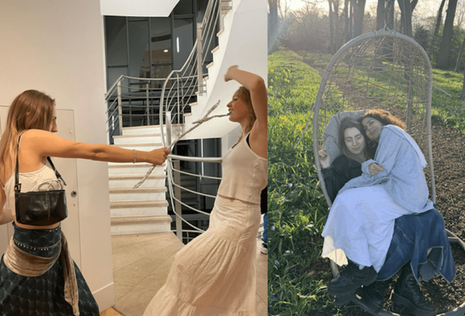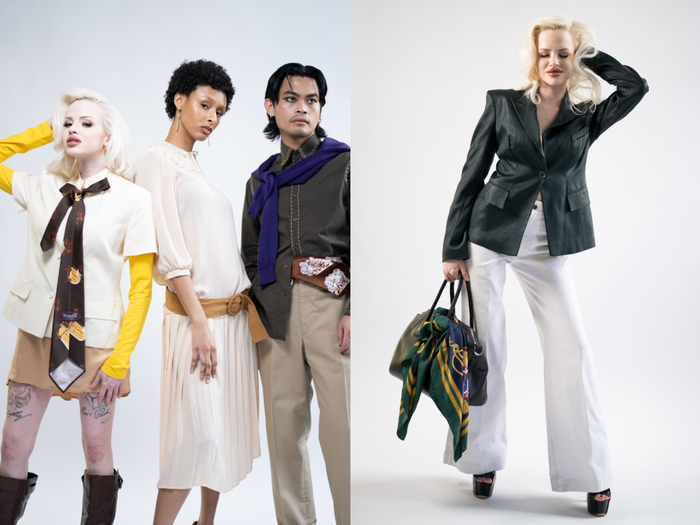Does the economy influence our fashion choices?
Jasmine Wong explores the impact of economic recessions on hemlines, make-up, and runway looks

As spring approaches, you might experience some excitement in finally being able to wear those long linen skirts once again. Funnily enough, that might also have something to do with the state of the economy. You might have heard of the well-known saying, “The shorter the skirt, the stronger the economy”. This is true – throughout history, skirt lengths have directly correlated with stock prices. This phenomenon is called the hemline index and was first noted by a Wharton Business School Professor when hemlines rose with the Roaring ’20s flapper dresses. With the Great Depression, hemlines fell once more, with women’s fashion switching back to a longer, more conservative style.
“Throughout history, skirt lengths have directly correlated with stock prices”
Now, with fast fashion and social media, trends are volatile and move at the speed of light. It has become much harder to determine what each year considers the “typical” skirt length. So does the hemline index still hold? Well, while the UK economy has fallen into a technical recession, maxi skirts and longer hemlines have been trending for winter and spring.
There are multiple theories for this correlation, with some suggesting that hemlines go up during good economic times to match the exuberant atmosphere and drop when the outlook is bad, reflecting a more sombre vibe. Other more practical reasons, like the high cost of silk stockings worn with shorter skirts in the 20th century, could also point to why this phenomenon occurs.
Other beauty trends are also curiously connected to the economy’s performance. The Japanese haircut indicator, taken from a 20-year-long study, shows that women spend more on their grooming habits (think fancy blowouts or high-maintenance hair colours) when the economy is doing well and tend to cut their hair shorter when a slump hits. The men’s underwear index, a favourite economic indicator of ex-Fed Chair Alan Greenspan, suggests that, while underwear is generally considered a necessity when the economic outlook is poor, men will not replace pairs they already have.
“In a stagnant economy, the ultra-wealthy typically opt for more muted looks”
The lipstick index demonstrates yet another correlation between beauty trends and the economy. It was first posited by the chairman of Estée Lauder when he noticed an uptick in the sale of lipstick after 9/11. The theory goes that purchases of smaller luxuries, like lipsticks, increase in times of economic downturn as consumers who may be unable to splurge on bigger ticket items like designer handbags turn to smaller purchases to treat themselves. While this theory is 20 years old, recent market research from Kantar Worldpanel found that, in the UK, lipstick sales were almost 10% higher than the previous year in the twelve weeks leading up to 18 September 2022. The numerous viral beauty trends and lip products bombarding our social media feeds – the Gisou and Dior lip oils, the recently released Rhode peptide lip treatment, or the Summer Fridays lip butter balm – might just point to the “lipstick effect”.
Fashion aesthetics that have been popular since 2023, like the “quiet luxury” or “old money aesthetic”, are also influenced by the economic recession and cost of living crisis. In a stagnant economy, the ultra-wealthy typically opt for more muted looks. This is not a new phenomenon, with Time Magazine dubbing the shift to black on the 2008 runways of Saint Laurent, Balenciaga, Lanvin, and many more “recession chic”. The rise of modest fashion and the comeback of business-casual elements in everyday casual wear, like power suits and everyday blazers, may be due to the practicality of such outfits. Andrew Groves, Professor of Fashion Design at the University of Westminster, told Oracle Time: “At times of economic downturn, high unemployment, and an uncertain future, not only do we adopt a far more traditional and formal approach to what we wear, but we also look for that in those with whom we want to do business”.
So, if you’ve found yourself drawn towards wearing longer skirts, splurging on an expensive beauty product, or investing in some business-casual pieces for your wardrobe, there may be data-backed reasons behind your choices. Fashion never exists in isolation. Trends in beauty and fashion and the purchases we make en masse – from luxury to necessities – require consideration of our finances and could very well reflect our collective, subconscious outlook on the economy.
 News / Local business in trademark battle with Uni over use of ‘Cambridge’17 January 2026
News / Local business in trademark battle with Uni over use of ‘Cambridge’17 January 2026 News / Cambridge bus strikes continue into new year16 January 2026
News / Cambridge bus strikes continue into new year16 January 2026 News / Uni members slam ‘totalitarian’ recommendation to stop vet course 15 January 2026
News / Uni members slam ‘totalitarian’ recommendation to stop vet course 15 January 2026 Interviews / The Cambridge Cupid: what’s the secret to a great date?14 January 2026
Interviews / The Cambridge Cupid: what’s the secret to a great date?14 January 2026 Science / Why smart students keep failing to quit smoking15 January 2026
Science / Why smart students keep failing to quit smoking15 January 2026










